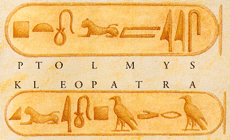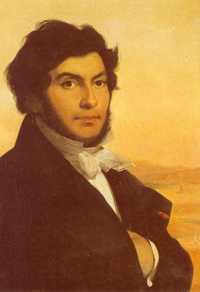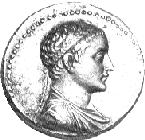|
Time Trips KS2 History and Science Workshops
How did we learn to translate hieroglyphs? The fascinating story of the Rosetta Stone...
|
||
|
When did hieroglyphic die out? The last hieroglyphic inscription from ancient times is on a wall in the Temple of Philae, dedicated to Isis, near Aswan in southern Egypt. It was written in AD 394 - more than 1600 years ago. After that the Egyptian language was lost, except in the form of Coptic. Coptic was the language used by early Christians in Egypt, which had many spoken words similar to ancient Egyptian. But hieroglyphic writing was lost, for over 1400 years.
|
The last hieroglyphs written in ancient times, in AD 394, in the Temple of Philae, on the Gate of Hadrian. |
The Middle Ages Scholars in the middle ages tried to work out what hieroglyphs meant. The Egyptians were thought of as very clever people, who had magic and all sorts of mystical, mysterious knowledge. But just about all the guesses these medieval scholars made were wrong. What they needed was a key - some sort of dictionary of Egyptian. The ideal thing would be to have some hieroglyphs already translated into a language they knew. And that was exactly what was found, in 1799. |
|
The Rosetta Stone In 1799, in a town called Rosetta, in the Nile Delta, one of Napoleon's soldiers found a big chunk of black stone covered in writing, called a stele. It became known as the Rosetta stone, and it turned out to be a very special chunk of granite. It's in the British Museum now, so next time you're in London go and have a look. Here's a picture of it If you look carefully, you can see there are three layers on the stone - three kinds of writing. The top one is hieroglyphic. The middle one is demotic, a later form of Egyptian used for every day purposes (a bit like hieratic). No one knew how to read either of these. But the bottom layer was ancient Greek. And lots of people knew how to read ancient Greek! |
|
Hieroglyphic
Demotic
Ancient Greek |
| see larger
version below |
||
|
Jean-Francois Champollion
|
So
how did the Rosetta Stone help?
Scholars were able to read the Greek inscription. They found out that it was all about a king, Ptolemy V, who ruled Egypt in 196BC, when the stone was made. It said how great and generous Ptolemy was, and so how every temple in the land should put up a statue of him, as well as a copy of this message (all pharaohs were bigheads). Soon the scholars realised that the three layers of writing were all saying the same thing! So now they knew what the hieroglyphic message was saying - but not which hieroglyphs meant which words. That was where the clever part came in. |
Ptolemy V |
|
Champollion
Jean-Francois Champollion was a very clever Frenchman. As a teenager he learned not only Latin and Greek, but Hebrew, Arabic, Syriac, Persian, Aramaic, and Coptic! He first saw a copy of the Rosetta Stone when he was 12, and he became fascinated with it. He was 32 before he finally began to understand the hieroglyphs. Another scholar had worked out where it said Ptolemy's name in the demotic inscription. Champollion now saw that Ptolemy's name was written in the cartouches, the oval shapes. The pictures on the right show one of these cartouches, and how the name was written in Greek. |
|
Champollion then looked at a cartouche from an obelisk at Philae, which he thought said 'Cleopatra'. Here's a close-up of what the cartouche said: |
|
PTOLEMAIOS |
|
|
| Can you see which hieroglyphs stand for which letters? The hieroglyphs actually say something more like 'Ptolmys' |
Can you see any hieroglyphs that are the same as in Ptolemy's name? What about the lion, and the box? Can you work out any other letters now? |
|
|
Comparing
Ptolemy and Cleopatra
Champollion could see that some of the hieroglyphs in Ptolemy were the same in Cleopatra. This helped him
to work out that Have you worked out the rest of the hieroglyphs? |
 |
The
The Key to Hieroglyphic There was a lot more hard work to go before Egyptian could be translated properly, but this was the beginning. Champollion and others used Coptic and other languages to help them work out other words, but the Rosetta Stone was the key to hieroglyphic. |
| This picture shows us how Champollion worked out what all the hieroglyphs in the two names were. This made it a lot easier to read other Egyptian words now. | ||





